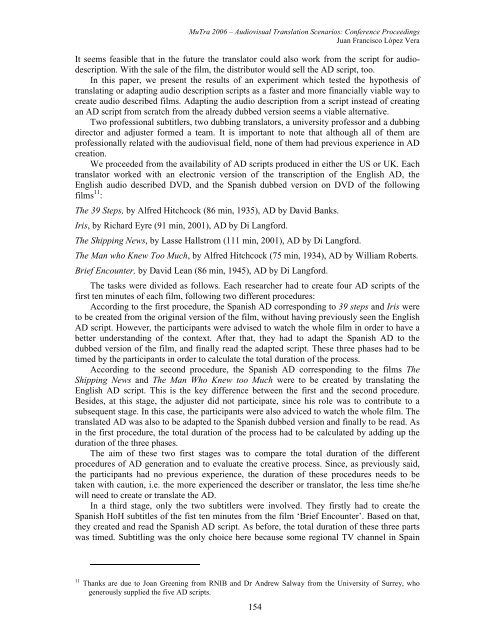Proceedings - Translation Concepts
Proceedings - Translation Concepts
Proceedings - Translation Concepts
Create successful ePaper yourself
Turn your PDF publications into a flip-book with our unique Google optimized e-Paper software.
MuTra 2006 – Audiovisual <strong>Translation</strong> Scenarios: Conference <strong>Proceedings</strong><br />
Juan Francisco López Vera<br />
It seems feasible that in the future the translator could also work from the script for audiodescription.<br />
With the sale of the film, the distributor would sell the AD script, too.<br />
In this paper, we present the results of an experiment which tested the hypothesis of<br />
translating or adapting audio description scripts as a faster and more financially viable way to<br />
create audio described films. Adapting the audio description from a script instead of creating<br />
an AD script from scratch from the already dubbed version seems a viable alternative.<br />
Two professional subtitlers, two dubbing translators, a university professor and a dubbing<br />
director and adjuster formed a team. It is important to note that although all of them are<br />
professionally related with the audiovisual field, none of them had previous experience in AD<br />
creation.<br />
We proceeded from the availability of AD scripts produced in either the US or UK. Each<br />
translator worked with an electronic version of the transcription of the English AD, the<br />
English audio described DVD, and the Spanish dubbed version on DVD of the following<br />
films 11 :<br />
The 39 Steps, by Alfred Hitchcock (86 min, 1935), AD by David Banks.<br />
Iris, by Richard Eyre (91 min, 2001), AD by Di Langford.<br />
The Shipping News, by Lasse Hallstrom (111 min, 2001), AD by Di Langford.<br />
The Man who Knew Too Much, by Alfred Hitchcock (75 min, 1934), AD by William Roberts.<br />
Brief Encounter, by David Lean (86 min, 1945), AD by Di Langford.<br />
The tasks were divided as follows. Each researcher had to create four AD scripts of the<br />
first ten minutes of each film, following two different procedures:<br />
According to the first procedure, the Spanish AD corresponding to 39 steps and Iris were<br />
to be created from the original version of the film, without having previously seen the English<br />
AD script. However, the participants were advised to watch the whole film in order to have a<br />
better understanding of the context. After that, they had to adapt the Spanish AD to the<br />
dubbed version of the film, and finally read the adapted script. These three phases had to be<br />
timed by the participants in order to calculate the total duration of the process.<br />
According to the second procedure, the Spanish AD corresponding to the films The<br />
Shipping News and The Man Who Knew too Much were to be created by translating the<br />
English AD script. This is the key difference between the first and the second procedure.<br />
Besides, at this stage, the adjuster did not participate, since his role was to contribute to a<br />
subsequent stage. In this case, the participants were also adviced to watch the whole film. The<br />
translated AD was also to be adapted to the Spanish dubbed version and finally to be read. As<br />
in the first procedure, the total duration of the process had to be calculated by adding up the<br />
duration of the three phases.<br />
The aim of these two first stages was to compare the total duration of the different<br />
procedures of AD generation and to evaluate the creative process. Since, as previously said,<br />
the participants had no previous experience, the duration of these procedures needs to be<br />
taken with caution, i.e. the more experienced the describer or translator, the less time she/he<br />
will need to create or translate the AD.<br />
In a third stage, only the two subtitlers were involved. They firstly had to create the<br />
Spanish HoH subtitles of the fist ten minutes from the film ‘Brief Encounter’. Based on that,<br />
they created and read the Spanish AD script. As before, the total duration of these three parts<br />
was timed. Subtitling was the only choice here because some regional TV channel in Spain<br />
11 Thanks are due to Joan Greening from RNIB and Dr Andrew Salway from the University of Surrey, who<br />
generously supplied the five AD scripts.<br />
154
















